The Hazards Of Attachments To Metal Roofs
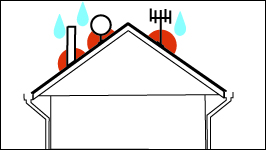 Metal roofing has been used extensively in New Zealand for over a hundred years. In certain locations (even some exposed situations i.e. close to the coast) the life of galvanised steel roofs has exceeded one hundred years, through appropriate maintenance and by minimising any damage to the roof caused by various sorts of interference.
Metal roofing has been used extensively in New Zealand for over a hundred years. In certain locations (even some exposed situations i.e. close to the coast) the life of galvanised steel roofs has exceeded one hundred years, through appropriate maintenance and by minimising any damage to the roof caused by various sorts of interference.
Like most things exposed to the harsh outdoor environment in New Zealand, metal roofs are affected by how they are maintained. Regular cleaning and painting when required will increase the roof life. Equally, lack of cleaning or care can reduce its service life. Some attachments quite commonly used on or with roofs can significantly shorten the life of the roof if not installed 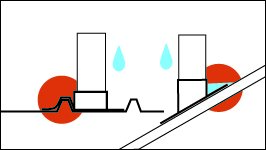 correctly, if made of incompatible materials or if they create a permanently wet area.
correctly, if made of incompatible materials or if they create a permanently wet area.
A metal roof will remain corrosion free and resistant to perforation for a long time provided it is washed freely by the rain and can dry, has no areas in which corrosion-causing deposits can build up, is not in continuous contact with incompatible metals and has regular routine maintenance carried out.
The sort of things that can reduce the life of the roof are continuing presence of leaves and dust or dirt (particularly when wet), damage or additions allowing ponding (permanently wet areas), installation of vents, chimneys, gutters, down pipes running on to a roof, gutter protection systems or any other devices which leave incompatible materials in permanent contact with (or running off onto) the metal roof.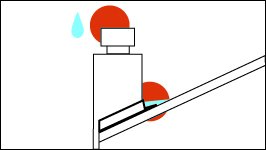
The Zincalume® coated steel currently used in the majority of metal based roofs has greatly superior durability compared with the old galvanised steel. However it does have the disadvantage that the adverse situations listed above can have an even greater and more rapid negative effect on its life than on the life of galvanised steel. Note that steel guttering, with either metal coating, can also suffer from these hazards, particularly from build-up of damp materials and from ponding.
The correct care and maintenance of a metal roof or gutter quite simply involves avoiding damage caused by:-
- Ponding - allow no dents or areas where water can rest permanentl. Provide correct sloping of flashings etc.,ensuring the product has the required fall for all water to drain.
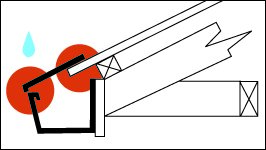
- Build up of atmospheric dust and dirt - washing by rainfall with the ability to dry out (and being prepared to wash unwashed areas with a hose and soft brush).
- Incompatible materials - either in wet contact with the roof or water running off such materials onto the roofing.
- Attachments installed to the roof with incorrect fasteners.
- Gutter debris - clearing out gutters and avoiding build-up of leaves etc
Typical examples of things which are likely to cause damage are:-
- Water from copper spouting running off onto Zincalume® based roofing, or splashing up onto the unwashed underside of the bottom of the roof;
- Walking or loads from e.g. air-conditioning units causing denting and ponding;
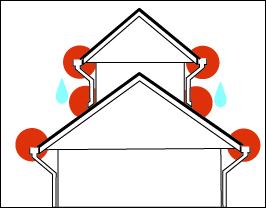
- Solar water heaters, gutter protection systems, satellite dishes etc fastened onto the top surface of the roof with incompatible
- fasteners, causing incompatible run-off, creating permanently wet areas, creating dirt traps for corrosive build-up, or preventing rain-washing;
- Penetrations (skylights etc), chimneys or flashings not angled so as to prevent ponding and dirt build-up.
- Tie wires or braces for pipes, aerials or flues made of incompatible materials and/or attached with incompatible fasteners.
There are of course many examples of all these things that have not caused problems and also quite a few where damage has occurred, sometimes requiring roof replacement at significant cost. Damage can sometimes take many years to show, so even in cases where no obvious damage has so far occurred, if one of the above poor practices has occurred the life of the roof and or guttering system is still likely to be impaired and future problems may yet arise.
The manufacturers of unpainted and prepainted steel or aluminium roofs offer good warranties but this does depend on the roofing not being damaged by such hazards as those listed above. Failures of roofing or guttering caused in this way will not be covered by the manufacturer's warranties, and so any 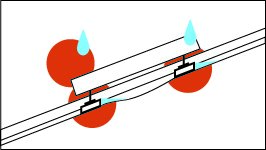 such fixtures, devices or systems must be specified, detailed and maintained so that they do not impact on the durability of the roof or invalidate the warranty.
such fixtures, devices or systems must be specified, detailed and maintained so that they do not impact on the durability of the roof or invalidate the warranty.
Note that the illustrations included here are schematic, not necessarily to scale, and show what NOT to do.
Refer to the NZMRM's NZ Metal Roof and Wall Cladding Code of Practice for detailed methods for CORRECT specification and installation of roof penetrations, flashings and attachments, including which materials are compatible / incompatible with each other.
